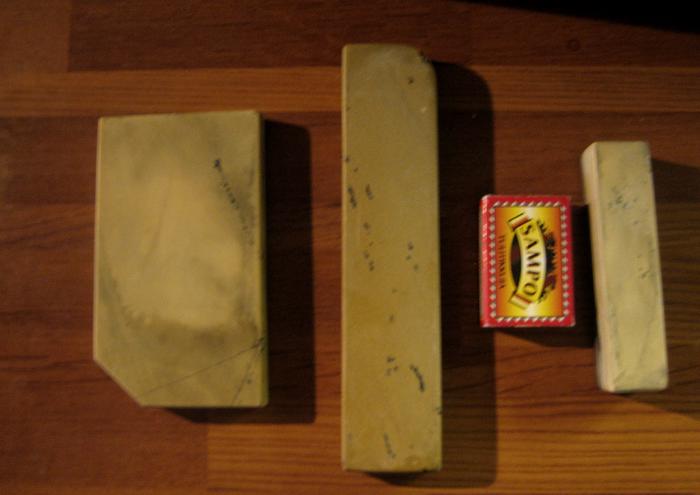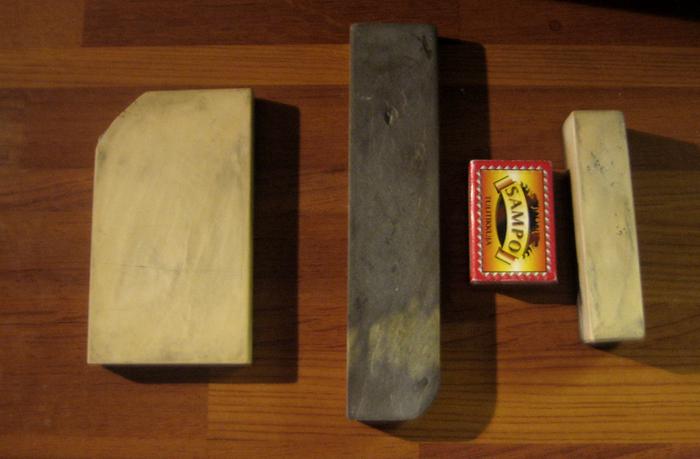View Poll Results: Finish honing with ... On a coticule.
- Voters
- 16. You may not vote on this poll
Results 31 to 40 of 41
Thread: Just when you think it's over..
-
10-28-2015, 10:01 AM #31

[QUOTE=Pithor;1559167]
Still, these are perfectly smooth edges, very keen and easy on the skin. But "melting off" stubble would be hyperbolic.
[QUOTE]
I mentioned this to you, Pithor, but I found the edges off two razors I bought from Cedric 'melting'.
I may have achieved them a few times myself at some time in the past - not sure who but just remember that feeling on a few of my razors, and in part it's behind my return to cotis.I love the smell of shaving cream in the morning!
-
10-28-2015, 02:30 PM #32

Some interesting points Pithor, it's always a pleasure to get your take on coticule related issues. As someone who I know is a respected coticule user.
I do think personal feelings and preferences have more to do with finding the one than just its properties as a hone. Thank you for sharing your experience with us.
Can we see a picture of your favourite coticule?
-
10-29-2015, 11:37 AM #33Senior Member

- Join Date
- May 2013
- Posts
- 143
Thanked: 32
It may be too early to ask, but did you feel like the hybrid side came off keener than your other coti edges?
Congrats on the stone BTW. Sounds like it's a good one.
-
10-29-2015, 01:29 PM #34

It would be a little biased to say because all my edges thus far have ended on the hybrid side. I can't resist its beauty. It's getting a nice polish on the stone too from use. Almost like a burnished ark, but not quite there. I also don't have a slurry stone so I haven't messed around with slurry yet. It's one hard coticule!
-
10-29-2015, 01:35 PM #35Senior Member

- Join Date
- May 2013
- Posts
- 143
Thanked: 32
Yeah they're crazy hard. You can dilute with any coti slurry stone on the hybrid side. Gary was the one that discovered this (I think) and it works very well.
-
10-29-2015, 01:36 PM #36Senior Member

- Join Date
- May 2013
- Posts
- 143
Thanked: 32
Oh...I remember now...you said you don't have any slurry stones. I thought you meant you didn't have a LL slurry stone. Scratch that. Lol
-
10-29-2015, 01:43 PM #37

No slurry stone whatsoever friend. I also don't want to do any heavy slurry work on this bad boy. I would need a small Coti 100/40 to do my heavy slurry work.
-
10-29-2015, 02:21 PM #38

I had one but swapped it for a stag Livi. Anyway, I tried that bevel setting to finish with the coticule a time or two or three, but gave that up and do the progression with synthetics before finishing. Not that it didn't work, but I have better things to do with my time and synthetic bevel setting is quicker.
When I had the les lat I did use the hybrid side as a final finisher.
The guy who first taught me to hone used to do 30 strokes on whatever finisher. I sort of took that as the default for a long time. Since then I've gotten away from a set number, as if there is a formula, but go by what I feel like the edge needs ........ IOW more, or less.Be careful how you treat people on your way up, you may meet them again on your way back down.
-
10-29-2015, 02:26 PM #39
-
11-13-2015, 09:50 AM #40

Even with regular, heavy slurrying, there is no way you will significantly wear the stone. I use thick slurry on all of mine, except the little La Petite Blanche because it really doesn't need it - meaning I use a less thick slurry than on the others.
These are all three of them together:

L to R: (1)Les Latneuses "hybrid" (2)Old, yellow side (3)La Petite Blanche, "pocket hone", yellow side

L to R: (1)Les Latneuses cream (2)Old, "blue" side (3)La Petite Blanche, "pocket hone", yellow side (I forgot to turn it over, but the blue side is really just...well, blue)
The one I have used the most thus far is the one on the left, the creamy side (You'll notice it looks dirty; that's because I never bother to clean my hones before or after honing. I slurry, I hone, I rinse, I'm done). It is the fastest all-rounder of the lot, although the hybrid side and the pocket hone are no slouches either. It is very straightforward and can be used for minor corrections and catching up at the watery end of the spectrum. Lately I've been mostly using the old one, though, and it is every bit as nice as the other ones. It is a pleasure to use, somewhat on the slow side on both slurry and water.
I have sporadically used the "blue" side on the old one, which is the most interesting of the lot. It has a tiny bit of yellow protruding and the slurry is almost white, with the most minimal pink hue. The transition from yellow to blue is very gradual, so if anything, that would be the real hybrid of the bunch. It has two dents, but I lapped it a bit and smoothed the edges on those dents, so they don't interfere with honing. I will need to give that side some more attention.
So my favourite? Hard to say. I like them all, but I tend to favour the two "larger" ones. That being said, the pocket hone is very capable in its own right, and a challenge due to its size and the fact that it auto-slurries ever so slightly.
If I had to pick a favourite at this point in time, I would go for the old one. It's a bit darker yellow (honey mustard), so it's a bit easier to see changes in slurry consistency than on the others. I really enjoy its feedback and feel as well. Aesthetically, it's very tough competition.
That being said, if you would have asked me two months ago, I probably would have said the creamy Les Latneuses side. If you ask me again in two weeks, I probably cannot answer any more sensibly. I like them all.
Funny thing, by the way: the pocket hone is by far the thickest, measuring in at a bit over 2 cm. The other two are a bit over 1 cm thick. I used to have a thicker hone, 2.5 cm, and I noticed I prefer thinner hones. Lighter, easier to manipulate in hand and more direct feedback.


 15Likes
15Likes LinkBack URL
LinkBack URL About LinkBacks
About LinkBacks






 Reply With Quote
Reply With Quote




